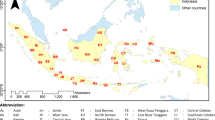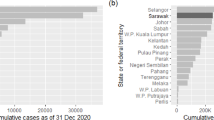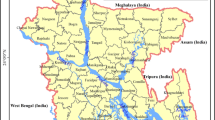Abstract
This research aims to analyze the factors and distribution pattern of the covid-19 virus in the localities of Zanjan city, because the outbreak of this pandemic has put the lives of many citizens at risk. Spatial statistics determine the temporal-spatial pattern of 21,638 people infected with the virus between Feb. 22 and Mar. 22, 2020. The geographic weighted regression and spatial autocorrelation have been used to find the relationship between the factors of the spread of the virus in the localities of Zanjan and its distribution. The results of spatial autocorrelation show that the spread of the Covid-19 pandemic in the localities of Zanjan is clustered and the concentration is more in vulnerable neighborhoods and informal settlements. Therefore, based on the results of the weighted geographic regression, the class nature of the effects and consequences of this pandemic is undeniable; a matter that is linked with independent and labor jobs, population density, unemployment, underlying diseases, the number of people in a room, household density in residential units, illiteracy, sex ratio; and appropriate policies free from discrimination in order to increase the economic equality of these neighborhoods will be effective in reducing the mortality of this disease.










Similar content being viewed by others
References
World Health Organization. (2020). Novel Coronavirus (2019-nCoV): Situation report.
Ministry of Health. (2019). https://behdasht.gov.ir
Alijani, B. (2015). Spatial analysis in geography studies. Journal of Spatial Analysis Environmental Hazards, 2(3), 1–14.
Lashgari Tafreshi, E. (2018). Explaining the concept of geographic space in positivist and hermeneutic methodology schools. Geography and Environmental Planning, 29(2), 35–54. https://doi.org/10.22108/gep.2018.98061.0
Crombie, I. K., Irvine, L., Elliott, L., & Wallace, H., & World Health Organization. Regional Office for Europe. (2005). Closing the health inequalities gap: An international perspective: Written by Iain K. Crombie. WHO Regional Office for Europe. https://apps.who.int/iris/handle/10665/107680
Bonizzato, P., & Tello, J. E. (2003). Social economic inequalities and mental health. I. Concepts, theories and interpretations. Epidemiology and Psychiatric Sciences, 12(3), 205–218. https://doi.org/10.1017/S1121189X00002980
Galobardes, B., & Morabia, A. (2003). Measuring the habitat as an indicator of socioeconomic position: Methodology and its association with hypertension. Journal of Epidemiology & Community Health, 57(4), 248–253. https://doi.org/10.1136/jech.57.4.248
Wang, F., & Luo, W. (2005). Assessing spatial and nonspatial factors for healthcare access: Towards an integrated approach to defining health professional shortage areas. Health & Place, 11(2), 131–146. https://doi.org/10.1016/j.healthplace.2004.02.003
Wang, L., Ardern, C. I., & Chen, D. (2020). Geographic variation in cardiovascular disease mortality: A study of linking risk factors and built environment at a local health unit in Canada. Geospatial Technologies for Urban Health. https://doi.org/10.1007/978-3-030-19573-1_3
Karlsen, S., & Nazroo, J. Y. (2002). Relation between racial discrimination, social class, and health among ethnic minority groups. American Journal of Public Health, 92(4), 624–631. https://doi.org/10.2105/ajph.92.4.624
Berry, B. J. L., & Marble, D. F. (Eds.). (1968). Spatial analysis: A reader in geography. Prentice-Hall. Incorporations. Englewood Cliffs.
Johnston, R. J., Gregory, D., & Smith, D. M. (Eds.). (1994). Spatial analysis Dictionary of human geography. Blackwell.
Seif, A., Entezari, M., Ghiyath, M., & Mortazavi, N. (2015). The spatial analysis of the environmental and climatic factors’ effects on skin cancer Case study: Isfahan province. Journal of Health System Research, 11(1), 170–183.
Pattison, W. D. (1964). The four traditions of geography. Journal of Geography, 63(5), 211–216.
Harvey, D. (1969). Explanation in geography. Arnold.
Batty, M. (1987). Book Review: Mathematical Methods in Human Geography and Planning by AG Wilson and RJ Bennett. Guidebook No. 7, Handbook of Applicable Mathematics. Chichester: John Wiley. 1985. p. 411. Urban Studies, 24(1), 87–89.
Goodchild, M. F. (1987). A spatial analytical perspective on geographical information systems. International Journal of Geographical Information System, 1(4), 327–334. https://doi.org/10.1080/02693798708927820
Bunge, W. (1966). Theoretical Geography. Second Edition, Lund Studies in Geography. Series C: General and Mathematical Geography.
Mohammadi, M. (2012). Zoning of Malt fever in Isfahan province. Master’s thesis in natural geography, medical geography. The supervisors are Mozhgan Inteziri and Alireza Taghian. Faculty of Geography. University of Esfahan.
Azarafza, M., Azarafza, M., & Akgün, H. (2020). Clustering method for spread pattern analysis of corona-virus (COVID-19) infection in Iran. medRxiv 2020-05. https://doi.org/10.1101/2020.05.22.20109942
Pribadi, D. O., Saifullah, K., Putra, A. S., Nurdin, M., & Rustiadi, E. (2021). Spatial analysis of COVID-19 outbreak to assess the effectiveness of social restriction policy in dealing with the pandemic in Jakarta. Spatial and Spatio-Temporal Epidemiology, 39, 100454. https://doi.org/10.1016/j.sste.2021.100454
Ahmadi, A., Fadaei, Y., Shirani, M., & Rahmani, F. (2020). Modeling and forecasting trend of COVID-19 epidemic in Iran until May 13, 2020. Medical Journal of the Islamic Republic of Iran, 34, 27. https://doi.org/10.34171/mjiri.34.27
Wang, J., Tang, K., Feng, K., & Lv, W. (2020). High temperature and high humidity reduce the transmission of COVID-19. Available at SSRN, 3551767.
Seyedi, S. J., Shojaeian, R., Hiradfar, M., Mohammadipour, A., & Alamdaran, S. A. (2020). Coronavirus disease 2019 (COVID-19) outbreak in pediatrics and the role of pediatricians: A systematic review. Iranian Journal of Pediatrics. https://doi.org/10.5812/ijp.102784
Tondelli, S., Farhadi, E., Akbari Monfared, B., Ataeian, M., Tahmasebi Moghaddam, H., Dettori, M., Saganeiti, L., & Murgante, B. (2022). Air quality and environmental effects due to COVID-19 in Tehran, Iran: Lessons for sustainability. Sustainability, 14(22), 15038.
Shojaei, S., Ashofteh, P., Dwijendra, N. K. A., Melesse, A. M., Shahvaran, A. R., Shojaei, S., & Homayoonnezhad, I. (2022). Impacts on global temperature during the first part of 2020 due to the reduction in human activities by COVID-19. Air, Soil and Water Research. https://doi.org/10.1177/11786221221101901
Thomas, G., Thomas, J., Mathew, A. V., Devika, R. S., Krishnan, A., & Nair, A. J. (2022). Non-uniform effect of COVID-19 lockdown on the air quality in different local climate zones of the urban region of Kochi, India. Spatial Information Research 1–11.
İçöz, C., & Yenilmez, İ. (2023). Spatio-temporal analysis of the COVID-19 pandemic in Türkiye: Results of the controlled normalization. Spatial Information Research, 31(1), 39–50.
Zhuang, Z., Zhao, S., Lin, Q., Cao, P., Lou, Y., Yang, L., & He, D. (2020). Preliminary estimation of the novel coronavirus disease (COVID-19) cases in Iran: A modelling analysis based on overseas cases and air travel data. International Journal of Infectious Diseases, 94, 29–31. https://doi.org/10.1016/j.ijid.2020.03.019
Wu, J. T., Leung, K., & Leung, G. M. (2020). Nowcasting and forecasting the potential domestic and international spread of the 2019-nCoV outbreak originating in Wuhan, China: A modelling study. The Lancet, 395(10225), 689–697. https://doi.org/10.1016/S0140-6736(20)30260-9
Chu, I. Y. H., Alam, P., Larson, H. J., & Lin, L. (2020). Social consequences of mass quarantine during epidemics: A systematic review with implications for the COVID-19 response. Journal of Travel Medicine, 27(7), taaa192.
Bavel, J. J. V., Baicker, K., Boggio, P. S., Capraro, V., Cichocka, A., Cikara, M., Crockett, M. J., Crum, A. J., Douglas, K. M., Druckman, J. N., Drury, J., & Willer, R. (2020). Using social and behavioural science to support COVID-19 pandemic response. Nature Human Behavior, 4(5), 460–471.
Liu, Y. L., Yuan, W. J., & Zhu, S. H. (2022). The state of social science research on COVID-19. Scientometrics, 1–15.
Daly, H. (2013). Ten policies for a steady-state economy. In AAAS Annual Meeting.
Iran Statistics Center. (2021). Statistical Yearbook of the Country, Tehran: Publications of the Directorate, Public Relations and International Cooperation Office of Iran Statistics Center.
Zanjan Medical Sciences. (2021). Zanjan Health Center Report.
Pineda, N. B., Bosque-Sendra, J., Gómez-Delgado, M., & Franco, R. (2010). Exploring the driving forces behind deforestation in the state of Mexico (Mexico) using geographically weighted regression. Applied Geography, 30(4), 576–591. https://doi.org/10.1016/j.apgeog.2010.05.004
Clement, F., Orange, D., Williams, M., Mulley, C., & Epprecht, M. (2009). Drivers of afforestation in Northern Vietnam: Assessing local variations using geographically weighted regression. Applied Geography, 29(4), 561–576. https://doi.org/10.1016/j.apgeog.2009.01.003
Zhang, P., Wong, D. W., So, B. K., & Lin, H. (2012). An exploratory spatial analysis of western medical services in Republican Beijing. Applied Geography, 32(2), 556–565. https://doi.org/10.1016/j.apgeog.2011.07.003
Chen, D. R., & Truong, K. (2012). Using multilevel modeling and geographically weighted regression to identify spatial variations in the relationship between place-level disadvantages and obesity in Taiwan. Applied Geography, 32(2), 737–745. https://doi.org/10.1016/j.apgeog.2011.07.018
Cahill, M., & Mulligan, G. (2007). Using geographically weighted regression to explore local crime patterns. Social Science Computer Review, 25(2), 174–193. https://doi.org/10.1177/08944393072989
Malczewski, J., & Poetz, A. (2005). Residential burglaries and neighborhood socioeconomic context in London, Ontario: Global and local regression analysis. The Professional Geographer, 57(4), 516–529. https://doi.org/10.1111/j.1467-9272.2005.00496.x
Gao, J., & Li, S. (2011). Detecting spatially non-stationary and scale-dependent relationships between urban landscape fragmentation and related factors using Geographically Weighted Regression. Applied Geography, 31(1), 292–302. https://doi.org/10.1016/j.apgeog.2010.06.003
Jensen, R. R., Gatrell, J. D., McLean, D. D., Hanham, R., & Spiker, J. S. (2005). Urban sprawl detection using satellite imagery and geographically weighted regression. Geo-Spatial Technologies in Urban Environments. https://doi.org/10.1016/j.apgeog.2010.06.003
Luo, J., & Wei, Y. H. D. (2009). Modeling spatial variations of urban growth patterns in Chinese cities: The case of Nanjing. Landscape and Urban Planning, 91(2), 51–64. https://doi.org/10.1016/j.landurbplan.2008.11.010
Fotheringham, A. S., Brunsdon, C., & Charlton, M. (2003). Geographically weighted regression: The analysis of spatially varying relationships. John Wiley & Sons.
Wong, W. S. D., & Lee, J. (2005). Statistical analysis of geographic information with ArcView GIS and ArcGIS. Wiley.
Seifolddini, F., & Mansourian, H. (2012). Pattern of urban services concentration and its environmental impacts on Tehran city. Journal of Environmental Studies, 37(60), 53–64.
General Department of Cooperative, Labor and Social Welfare of Zanjan Province. (2021). Monthly employment and unemployment report of Zanjan city.
Ahadnejad, M., Najafi, S., & Mohamadi Torkamani, H. (2020). Analysis of factors affecting the urban life quality (Case study: Islamabad and Karmandan Neighborhoods City of Zanjan). Journal of Studies of Human Settlements Planning, 15(1), 185–198.
Author information
Authors and Affiliations
Corresponding author
Ethics declarations
Conflict of interest
The authors declare no conflicts of interest.
Additional information
Publisher's Note
Springer Nature remains neutral with regard to jurisdictional claims in published maps and institutional affiliations.
Rights and permissions
Springer Nature or its licensor (e.g. a society or other partner) holds exclusive rights to this article under a publishing agreement with the author(s) or other rightsholder(s); author self-archiving of the accepted manuscript version of this article is solely governed by the terms of such publishing agreement and applicable law.
About this article
Cite this article
Ahadnejad Reveshty, M., Heydari, M.T. & Tahmasebimoghaddam, H. Spatial analysis of the factors impacting on the spread of Covid-19 in the neighborhoods of Zanjan, Iran. Spat. Inf. Res. 32, 151–164 (2024). https://doi.org/10.1007/s41324-023-00550-0
Received:
Revised:
Accepted:
Published:
Issue Date:
DOI: https://doi.org/10.1007/s41324-023-00550-0




